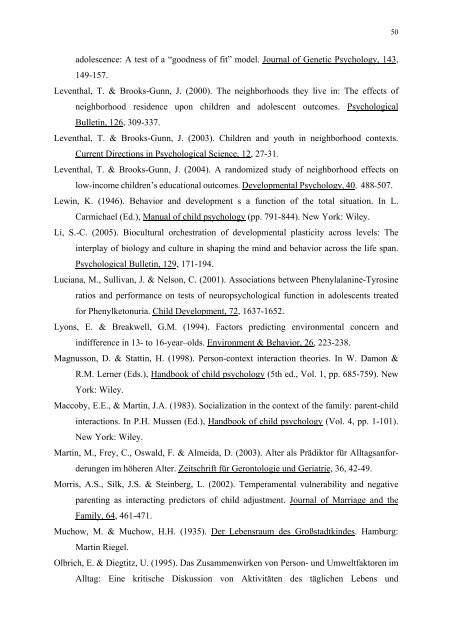Die Rolle der Umwelt in der Entwicklungspsychologie Martin ...
Die Rolle der Umwelt in der Entwicklungspsychologie Martin ...
Die Rolle der Umwelt in der Entwicklungspsychologie Martin ...
Erfolgreiche ePaper selbst erstellen
Machen Sie aus Ihren PDF Publikationen ein blätterbares Flipbook mit unserer einzigartigen Google optimierten e-Paper Software.
adolescence: A test of a “goodness of fit” model. Journal of Genetic Psychology, 143,<br />
149-157.<br />
Leventhal, T. & Brooks-Gunn, J. (2000). The neighborhoods they live <strong>in</strong>: The effects of<br />
neighborhood residence upon children and adolescent outcomes. Psychological<br />
Bullet<strong>in</strong>, 126, 309-337.<br />
Leventhal, T. & Brooks-Gunn, J. (2003). Children and youth <strong>in</strong> neighborhood contexts.<br />
Current Directions <strong>in</strong> Psychological Science, 12, 27-31.<br />
Leventhal, T. & Brooks-Gunn, J. (2004). A randomized study of neighborhood effects on<br />
low-<strong>in</strong>come children’s educational outcomes. Developmental Psychology, 40, 488-507.<br />
Lew<strong>in</strong>, K. (1946). Behavior and development s a function of the total situation. In L.<br />
Carmichael (Ed.), Manual of child psychology (pp. 791-844). New York: Wiley.<br />
Li, S.-C. (2005). Biocultural orchestration of developmental plasticity across levels: The<br />
<strong>in</strong>terplay of biology and culture <strong>in</strong> shap<strong>in</strong>g the m<strong>in</strong>d and behavior across the life span.<br />
Psychological Bullet<strong>in</strong>, 129, 171-194.<br />
Luciana, M., Sullivan, J. & Nelson, C. (2001). Associations between Phenylalan<strong>in</strong>e-Tyros<strong>in</strong>e<br />
ratios and performance on tests of neuropsychological function <strong>in</strong> adolescents treated<br />
for Phenylketonuria. Child Development, 72, 1637-1652.<br />
Lyons, E. & Breakwell, G.M. (1994). Factors predict<strong>in</strong>g environmental concern and<br />
<strong>in</strong>difference <strong>in</strong> 13- to 16-year–olds. Environment & Behavior, 26, 223-238.<br />
Magnusson, D. & Statt<strong>in</strong>, H. (1998). Person-context <strong>in</strong>teraction theories. In W. Damon &<br />
R.M. Lerner (Eds.), Handbook of child psychology (5th ed., Vol. 1, pp. 685-759). New<br />
York: Wiley.<br />
Maccoby, E.E., & Mart<strong>in</strong>, J.A. (1983). Socialization <strong>in</strong> the context of the family: parent-child<br />
<strong>in</strong>teractions. In P.H. Mussen (Ed.), Handbook of child psychology (Vol. 4, pp. 1-101).<br />
New York: Wiley.<br />
Mart<strong>in</strong>, M., Frey, C., Oswald, F. & Almeida, D. (2003). Alter als Prädiktor für Alltagsanfor<strong>der</strong>ungen<br />
im höheren Alter. Zeitschrift für Gerontologie und Geriatrie, 36, 42-49.<br />
Morris, A.S., Silk, J.S. & Ste<strong>in</strong>berg, L. (2002). Temperamental vulnerability and negative<br />
parent<strong>in</strong>g as <strong>in</strong>teract<strong>in</strong>g predictors of child adjustment. Journal of Marriage and the<br />
Family, 64, 461-471.<br />
Muchow, M. & Muchow, H.H. (1935). Der Lebensraum des Großstadtk<strong>in</strong>des. Hamburg:<br />
Mart<strong>in</strong> Riegel.<br />
Olbrich, E. & <strong>Die</strong>gtitz, U. (1995). Das Zusammenwirken von Person- und <strong>Umwelt</strong>faktoren im<br />
Alltag: E<strong>in</strong>e kritische Diskussion von Aktivitäten des täglichen Lebens und<br />
50

















